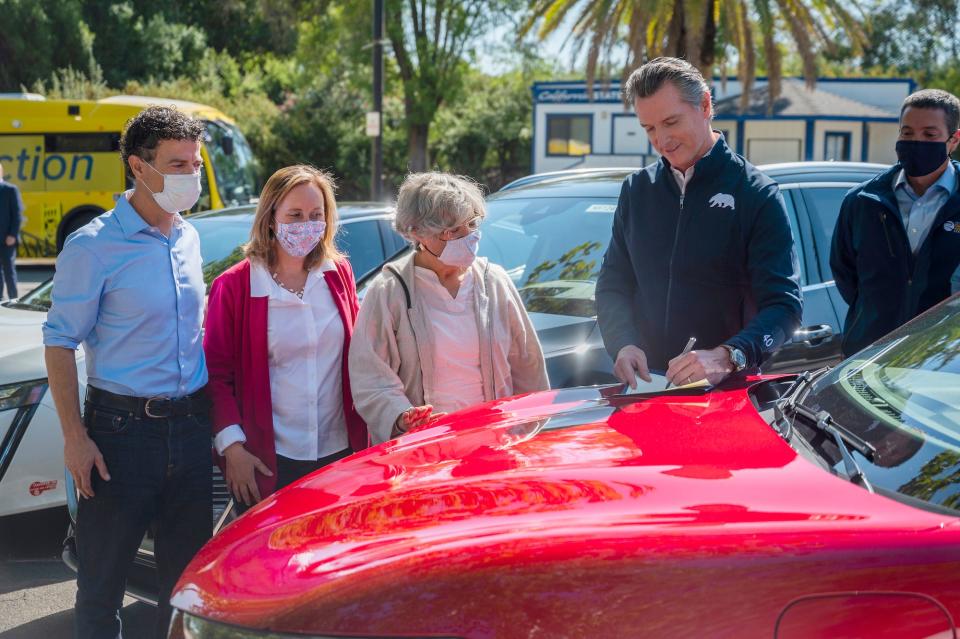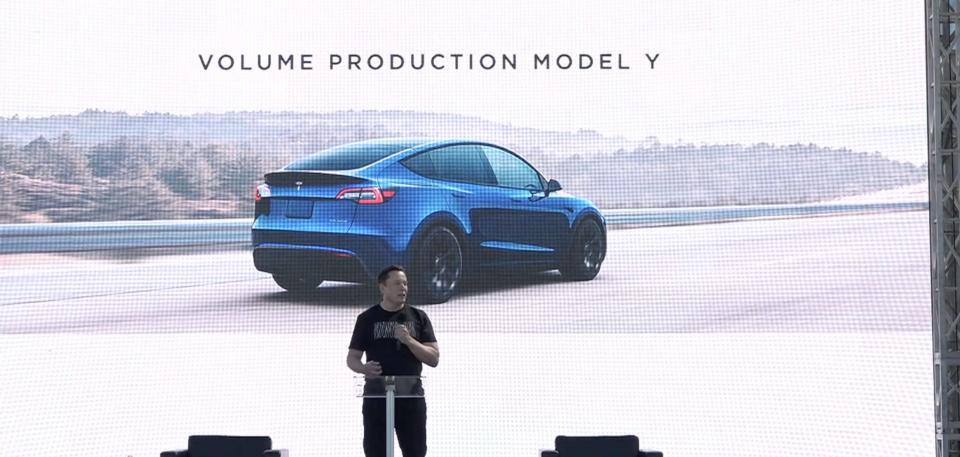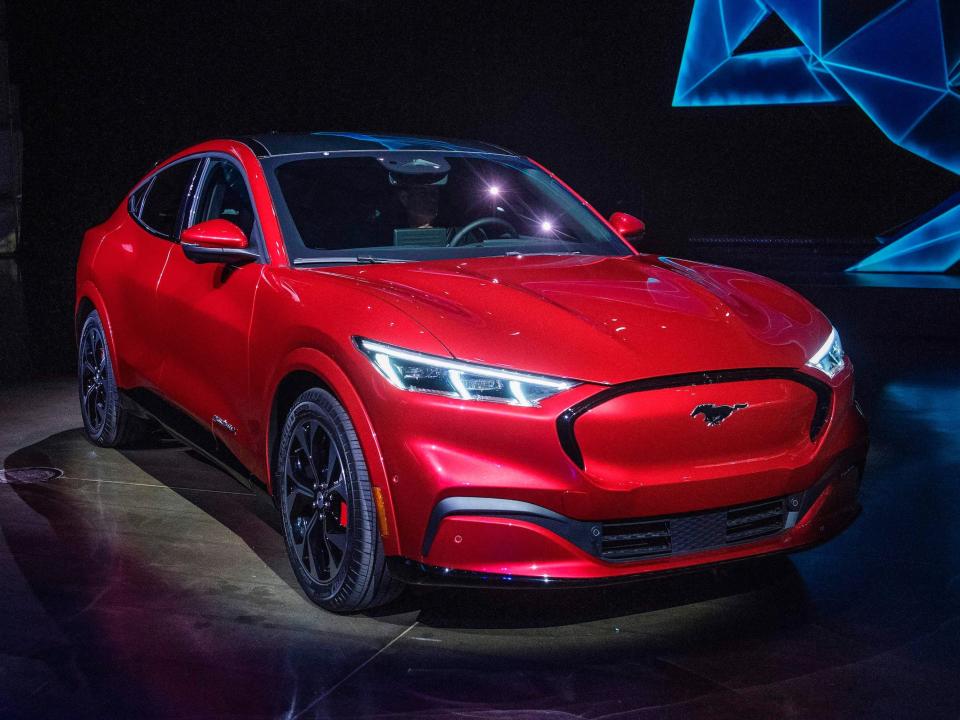California's ban of gas-powered cars by 2035 looks great for Tesla, but could distract the young automaker from its best chance to grow

Daniel Kim/The Sacramento Bee via AP, Pool
Tesla is ideally positioned to take advantage of California's move to ban internal-combustion vehicle sales by 2035.
But Gov. Gavin Newsom's executive order could also be seen as a potential distraction from a much bigger opportunity for Tesla to grow outside of California and the US.
The challenge is that US vehicle market growth — for gas cars and EVs — is capped, while the total China market could double in the next two decades.
For Tesla, the dilemma is whether to stay big at home or go bigger in China.
When California Gov. Gavin Newsom announced last week that the state would ban new sales of internal-combustion engines after 2035, the obvious and immediate reaction was, "This has to be great news for Tesla!"
And it is great news for America's dominant electric-vehicle manufacturer, which currently makes almost all its cars in the Golden State. Prior to the coronavirus pandemic, Tesla was on track to sell nearly 50,000 vehicles in California through the second quarter. A combination of heavily taxed gasoline and perks for zero-emission vehicles has given Left Coasters ample reason to go electric.
California accounts for about 11% of all new vehicle sales in the US, so even though the 2035 ICE ban is a long way off — and might not be politically feasible, long term, as it was formulated as an executive order, not legislation — it has the attention of the auto industry.
"Ford is proud to be the only American automaker to stand with California for reduced greenhouse gas emissions," Jim Farley, Ford's soon-to-be-new CEO, said in a tweet. "We want to leave a better world to the next generation." (Ford, Volkswagen, BMW, and Honda joined California is a 2019 dispute with the Trump administration EPA over fuel-economy standards.)
For Tesla, an ideal position isn't actually ideal for capturing future market growth outside the US

Tesla/Youtube
But Tesla has a big lead already, which will only get bigger as the company pushes toward selling a million vehicles a year. That milestone would secure fully half of the California market — not a terribly far-fetched development, as Tesla wants to build a new factory in Texas to cover the US east of the Mississippi and a new plant in Germany, freeing up its California facility to supply the US western region by itself.
In a research note published after Newsom's announcement, Morgan Stanley analysis Adam Jonas noted that Tesla is the automaker best-positioned to benefit from an ICE ban. However, the next decade-and-a-half could be tricky for Tesla to negotiate in its home state.
For starters, the overall new-vehicle market in the US isn't going to grow. In fact, it isn't clear that Tesla's considerable sales have displaced sales of gas-powered vehicles, or whether the company has simply created a sort of parallel market in EV sales — in effect creating new market share that it can dominate.
And depending on what happens with urban development and auto ownership in California, vehicle sales there could instead decline. Meanwhile, Tesla's Fremont factory lacks the capacity to continue to dominate demand in California, as that demand shifts to electric. (Fremont can build around 400,000 vehicles every year, but about two million new cars and trucks are sold in the state annually.)
This presents a dilemma for CEO Elon Musk and his 17-year-old company: build a second car plant in the West to capture more of California, or expand instead in the market where major-league growth is more likely to happen. That would be China.
Tesla is already operating the sole remaining vehicle assembly plant in California. Adding another facility in the heavily regulated state would be expensive and time-consuming, a contrast with Tesla's new plant in China, which went from a hole in the ground to rolling out vehicles in 15 months.
Musk recently said that Tesla needs to sell 20 million vehicles annually to displace enough ICE vehicles from the global fleet to mitigate global warming, so the options are to either take over huge chunks of the US and European markets, or to go after lower-hanging growth in China.
More competition in California than Tesla has ever faced before

Mark Ralston/AFP via Getty Images
Mind you, Tesla stands to grow a more profitable business if a state as big as California helps to create a semi-captive market for the company's vehicles. Many of Tesla's most affluent customers live in the Golden State, and they should be important long-term as the automaker works to generate consistent, double-digit margins.
But then again, 15 years isn't tomorrow, and if Tesla is distracted by picking up market share in California, it could fall off the pace in China. Tesla has more money in the bank than ever before, but the extra billions aren't enough to expand on two continents simultaneously.
That's the risk. Fortunately, Tesla is no longer going it alone. Both Ford and GM are moving aggressively to introduce EVs, and both carmakers see California as a growth opportunity for them, given their historic sales weakness in the Golden State. The top two US automakers control 30% of the total US market, but in California, their Japanese competitors own almost half the yearly sales.
But GM, in particular, is ahead of the Japanese carmakers on an EV master plan, aiming to launch 22 new vehicles by 2023 (and forming an alliance in the US with Honda to share costs). So Tesla doesn't have to take needless risks because other major automakers are taking aim at California. Tesla has already done its work in the state and can shift to attacking new opportunities (and it already is, by building a Cybertruck plant in Texas and going after GM and Ford's bread-and-butter, pickups).
In the end, if California follows through on its 2035 mandate, Tesla could be looking at a discipline challenge. It would be hard to pass up California, given that much of the value of Tesla's brand — and its $395-billion market capitalization — is thanks to many happy Californians buying Teslas and broadcasting their zero-emissions ethos to the world. That's the main reason that Tesla gets away with spending almost nothing on advertising.
But as tempting as California is, it isn't where the serious growth is. And competition in the state could be ferocious. These are good challenges to have, but before we argue that Newsom's initiative is the best thing that ever happened to Tesla, we have to consider that Tesla now belongs to more than just one US state.
Read the original article on Business Insider

